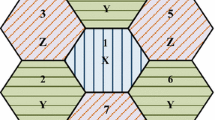Abstract
We propose a dynamic load balancing scheme for the channel assignment problem in a cellular mobile environment. As an underlying approach, we start with a fixed assignment scheme where each cell is initially allocated a set of channels, each to be assigned on demand to a user in the cell. A cell is classified as 'hot', if the degree of coldness of a cell (defined as the ratio of the number of available channels to the total number of channels for that cell), is less than or equal to some threshold value. Otherwise the cell is 'cold'. Our load balancing scheme proposes to migrate unused channels from underloaded cells to an overloaded one. This is achieved through borrowing a fixed number of channels from cold cells to a hot one according to a channel borrowing algorithm. A channel assignment strategy is also proposed based on dividing the users in a cell into three broad types – 'new', 'departing', 'others' – and forming different priority classes of channel demands from these three types of users. Assignment of the local and borrowed channels are performed according to the priority classes. Next, a Markov model for an individual cell is developed, where the state is determined by the number of occupied channels in the cell. The probability for a cell being hot and the call blocking probability in a hot cell are derived, and a method to estimate the value of the threshold is also given. Detailed simulation experiments are carried out in order to evaluate our proposed methodology. The performance of our load balancing scheme is compared with the fixed channel assignment, simple borrowing, and two existing strategies with load balancing (e.g., directed retry and CBWL), and a significant improvement of the system behavior is noted in all cases.
Similar content being viewed by others
References
D.C. Cox and D.O. Reudink, Increasing channel occupancy in large scale mobile radio systems: dynamic channel reassignment, IEEE Transactions on Vehicle Technology 22 (November 1973) 218–222.
S.K. Das, S.K. Sen and R. Jayaram, A dynamic load balancing strategy for channel assignment using selective borrowing in cellular mobile environment, in: Proceedings of IEEE/ACM Conference on Mobile Computing and Networking (MOBICOM '96), Rye, NY (November 1996) pp. 73–84.
S.K. Das, S.K. Sen and R. Jayaram, A structured channel borrowing scheme for dynamic load balancing in cellular networks, in: Proceedings of IEEE International Conference on Distributed Computing Systems (ICDCS), Baltimore, MD (May 1997) pp. 116–123.
S.K. Das, S.K. Sen, R. Jayaram and P. Agrawal, A distributed load balancing algorithm for the hot cell problem in cellular mobile networks, in: Proceedings of Sixth IEEE International Symposium on High Performance Distributed Computing (HPDC), Portland, OR (August 1997).
M. Duque-Anton, D. Kunz and B. Ruber, Channel assignment for cellular radio using simulated annealing, IEEE Transactions on Vehicle Technology 42 (February 1993).
B. Eklundh, Channel utilization and blocking probability in a cellular mobile telephone system with directed retry, IEEE Transactions on Communications 34(4) (April 1986).
S.M. Elnoubi, R. Singh and S.C. Gupta, A new frequency channel assignment in high capacity mobile communication systems, IEEE Transactions on Vehicle Technology 31(3) (August 1982).
D. Hong and S.S. Rappaport, Traffic model and performance analysis for cellular mobile radio telephone systems with prioritized and non-prioritized hand-off procedures, IEEE Transactions on Vehicle Technology 35 (August 1986).
H. Jiang and S.S. Rappaport, CBWL: A new channel assignment and sharing method for cellular communication systems, IEEE Transactions on Vehicle Technology 43(2) (May 1994).
J. Karlsson and B. Eklundh, A cellular mobile telephone system with load sharing – an enhancement of directed retry, IEEE Transactions on Communications 37(5) (May 1989).
W.C.Y. Lee, Mobile Cellular Telecommunication Systems, Analog and Digital Systems (McGraw-Hill, 2nd ed., 1996).
V.H. Macdonald, Advanced mobile phone service: The cellular concept, Bell Syst. Tech. J. 58 (January 1979) 15–41.
R. Nelson, Probability, Stochastic Processes and Queueing Theory (Springer, 1996).
J. Tajima and K. Imamura, A strategy for flexible channel assignment in mobile communication systems, IEEE Transactions on Vehicle Technology 37 (May 1988).
S. Tekinay and B. Jabbari, Handover and channel assignment in mobile cellular network, IEEE Communication Magazine (November 1991).
M.H. Willebeek-LeMair and A.P. Reeves, Strategies for dynamic load balancing on highly parallel computers, IEEE Transactions on Parallel and Distributed Systems 4(9) (September 1993).
M. Zhang and T.S. Yum, Comparisons of channel assignment strategies in cellular mobile telephone systems, IEEE Transactions on Vehicle Technology 38 (November 1989).
Author information
Authors and Affiliations
Rights and permissions
About this article
Cite this article
Das, S.K., Sen, S.K. & Jayaram, R. A dynamic load balancing strategy for channel assignment using selective borrowing in cellular mobile environment. Wireless Networks 3, 333–347 (1997). https://doi.org/10.1023/A:1019181923135
Issue Date:
DOI: https://doi.org/10.1023/A:1019181923135




